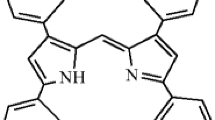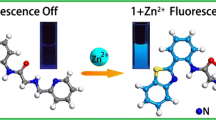Abstract
A new fluorophore, 4-methyl-2-(2-pyridyl)-5-(2-thiophenyl)thiazole (2-PTT), was reported as a ratiometically fluorescent sensor of zinc(II) based on dual-emission with selectivity and sensitivity. Two emission bands at 440 and 497 nm were observed before and after addition of zinc(II), respectively. Job’s plot disclosed the 1:1 stoichiometry between 2-PTT and zinc(II). The binding constant was evaluated as 2.09 × 105 M−1 based on fluorescence titration experiment.






Similar content being viewed by others
References
Andreini C, Banci L, Bertini I, Rosato A (2006) Zinc through the three domains of life. J Proteome Res 5:3173–3178
Berg JM, Shi Y (1996) The galvanization of biology: a growing appreciation for the roles of zinc. Science 271:1081–1085
Frassinetti S, Bronzetti G, Caltavuturo L, Cini M, Croce CD (2006) The role of zinc in life: a review. J Environ Pathol Toxicol Oncol 25:579–610
Dunn MF (2005) Zinc-ligand interactions modulate assembly and stability of the insulin hexamer-a review. Biometals 18:295–303
Bush AL, Pettingell WH, Multhaup G, d Paradis M, Vonsattel JP, Gusella JF, Beyreuther K, Masters CL, Tanzi RE (1994) Rapid induction of Alzheimer a beta amyloid formation by zinc. Science 265:1464–1467
Koh JY, Suh SW, Gwag BJ, He YY, Hsu CY, Choi DW (1996) The role of zinc in selective neuronal death after transient global cerebral ischemia. Science 272:1013–1016
Walker CF, Black RE (2004) Zinc and the risk for infectious disease. Annu Rev Nutr 24:255–275
Xu ZC, Yoon J, Spring DR (2010) Fluorescent chemosensors for zinc. Chem Soc Rev 39:1996–2006
Aileen C (2004) Responsive lanthanide complexes for metal ion sensing. Durham theses, Durham University
Ajayaghosh A, Carol P, Sreejith S (2005) A ratiometric fluorescence probe for selective visual sensing of Zn. J Am Chem Soc 127:14692–14693
Lv Y, Cao M, Li J, Wang J (2013) A sensitive ratiometric fluorescent sensor for zinc with high selectivity. Sensors 13:3131–3141
Liu M, Tan H, Liu Z, Wang W, Zeng W (2013) Advances in fluorescent probes based on the small molecules for Zn2+. Chin J Org Chem 33:1655–1667
Zheng M-H, Jin J-Y, Sun W, Yan C-H (2006) A new series of fluorescent 5-methoxy-2-pyridylthiazoles with a pH-sensitive dual-emission. New J Chem 30:1196–1196
Li L-L, Sun H, Fang C-J, Xu J, Jin J-Y, Yan C-H (2007) Optical sensors based on functionalized mesoporous silica SBA-15 for the detection of multianalytes (H+ and Cu2+) in water. J Mater Chem 17:4492–4498
Zheng M-H, Zhang M-M, Li H-H, Jin J-Y (2012) Digital pH fluorescent sensing shown by small organic molecules. J Fluores 22:1421–1424
Zheng M-H, Sun W, Jin J-Y, Yan C-H (2014) Molecular keypad locks based on gated photochromism and enhanced fluorescence by protonation effects. J Fluores 14:1169–1176
Zheng M-H, Liu X-L, Jin J-Y (2014) Synthesis of 2,4-di((5-methoxy-2-thiazoyl) pyridine and its fluorescent responses to Ag+ and pH. J Yanbian Univ (Nat Sci) 40:38–41
Karrer P, Schukri J (1945) Compounds containing thiazole, phenyl, and pyridine rings in chain linkages. Helv Chim Acta 28:820–824
Yang R, Li K, Wang K, Zhao F, Li N, Liu F (2003) Porphyrin assembly on β-cyclodextrin for selective sensing and detection of a zinc ion based on the dual emission fluorescence ratio. Anal Chem 75:612–621
Du J, Fan J, Peng X, Li H, Sun S (2010) The quinoline derivative of ratiometric and sensitive fluorescent zinc probe based on deprotonation. Sens Actuators, B 144:337–341
Shortreed M, Kopelman R, Kuhn M, Hoyland B (1997) Fluorescent fiber-optic calcium sensor for physiological measurements. Anal Chem 68:1414–1418
Acknowledgments
We thanks the financial supports from the National Natural Science Foundation of China (NSFC 21062023).
Author information
Authors and Affiliations
Corresponding author
Rights and permissions
About this article
Cite this article
Zheng, MH., Hu, X., Yang, MY. et al. Ratiometically Fluorescent Sensing of Zn(II) Based on Dual-Emission of 2-Pyridylthiazole Derivatives. J Fluoresc 25, 1831–1834 (2015). https://doi.org/10.1007/s10895-015-1675-1
Received:
Accepted:
Published:
Issue Date:
DOI: https://doi.org/10.1007/s10895-015-1675-1




